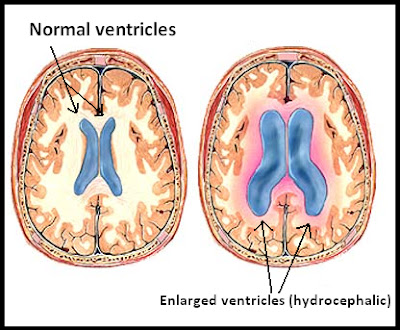What
is hydrocephalus?
The
word hydrocephalus is a condition where fluid in the brain builds up to excessive
and dangerous amounts. Hydrocephalus comes from the Greek words “hydro”,
meaning water, and “cephalus”, meaning head. This brain fluid is called cerebrospinal
fluid (or CFS for short). CFS is a clear fluid that surrounds the brain and
spinal cord. CFS’s main functions are to keep the brain tissue healthy and buoyant
by acting as a “shock absorber” and deliver nutrients to the brain and then
help remove waste.
The
excessive accumulation of CSF results in an abnormal widening of spaces in the
brain called ventricles. This widening creates potentially harmful pressure on
the tissues of the brain. Normally, CSF flows through the ventricles, exits
into cisterns (closed spaces that serve as reservoirs) at the base of the
brain, bathes the surfaces of the brain and spinal cord, and then reabsorbs
into the bloodstream.
The
balance between production and absorption of CSF is very important. Because CSF
is made continuously, any medical condition that prohibits or hinders the re-absorption
and dissolution of CFS, like hydrocephalus, will result in painful pressure of
the fluid against the brain tissue.
Hydrocephalus
is either congenital or acquired. Congenital hydrocephalus, meaning it is
present at birth, may be caused by either events or influences that occur
during fetal development, or genetic abnormalities. Acquired hydrocephalus,
meaning the condition develops over time or later in life, can affect people at
any age and may be caused by injury or disease, such as head trauma, infection,
tumors, or surgical complications.
Hydrocephalus
may also be communicating or non-communicating. Communicating hydrocephalus
occurs when the flow of CSF is blocked after it exits the ventricles. This form
is called communicating because the CSF can still flow between the ventricles,
which remain open. Non-communicating hydrocephalus - also called
"obstructive" hydrocephalus - occurs when the flow of CSF is blocked
along one or more of the narrow passages connecting the ventricles. One of the
most common causes of hydrocephalus is "aqueductal stenosis." In this
case, hydrocephalus results from a narrowing of the aqueduct of Sylvius, a
small passage between the third and fourth ventricles in the middle of the
brain.
Next time,
we’ll talk about symptoms, research, and treatments. (p.s. all of this research
and information came from medicine.net and hydroassoc.org. Check them out for
more info!)
And
speaking of things you can do to help….
Have
you donated to the RunCarlaRun First Giving Donation Fund yet? 100% of all
donations go to the Hydrocephalus Association. We are only at 6% of our goal.
LET’S GO PEOPLE! Go HERE to donate NOW!






No comments:
Post a Comment